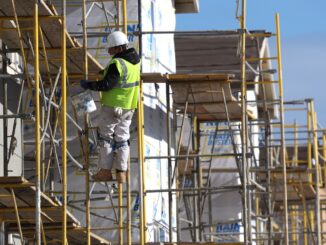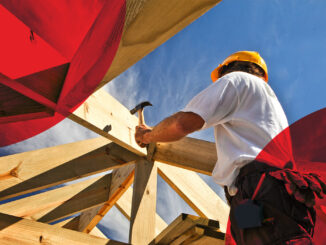
After pulling back at the start of the year, homebuilders jumped back in during February as homebuyer demand and builder confidence trended upward.
Homes were started at an estimated annual pace of 1.45 million in February, up 9.8% month over month, according to a report released Thursday by the U.S. Census Bureau and the U.S. Department of Housing and Urban Development (HUD).
Despite the month-over-month increase, housing starts were still down 18.4% year over year thanks to the annual pace of single-family housing starts dropping to 830,000, a decline of 31.6% year over year.
“The pace of new construction had been picking up over the past two years. In 2022, a total of 1.55 million new housing units were started, which is a little higher than the average annual new starts over the past five decades,” Lisa Sturtevant, the chief economist at Bright MLS, said in a statement. “However, the amount of new housing being built is still far below what is needed to meet demand and help moderate high prices.”
Unlike last month, multi-family housing starts were up both month over month and year over year, rising 24.1% and 14.3%, respectively, to a pace of 608,000.
As the pace of housing starts rose in February, so did the pace of completions, which were up 12.2% month over month and 12.8% year over year to a pace of 1.557 million. Although the pace of single-family completions was up 1.0% from a month ago, the pace of 1.037 million is still down 3.6% compared to a year ago. The pace of multi-family completions (509,000), on the other hand, posted massive increases both month over month and year over year, at 44.6% and 72.0%, respectively.
“Completions have outpaced starts since July 2022 and that will likely continue to put downward pressure on the number of single-family homes under construction. Builders may focus on completing existing projects, rather than starting new ones,” Odeta Kushi, First American’s deputy chief economist, said in a statement. “As the inventory of new, completed homes rises, it will provide some much-needed relief to a supply-starved market and put downward pressure on new-home prices.”
Although homebuilder sentiment in sales expectations for the next six months did drop slightly in the most recent National Association of Home Builders (NAHB)/Wells Fargo Housing Market Index (HMI) report, building permits are starting to trend upward, at least on a monthly basis. In February, building permits were issued at an estimated annual pace of 1.524 million, up 13.4% from a month prior, however this is still down 17.9% year over year.
“Single-family housing permits, a leading indicator of future starts, also increased 7.6% compared with the previous month,” Kushi said. “The uptick in single-family housing permits and starts aligns with the recent increase in homebuilder sentiment.”
Despite this uptick, experts are still just cautiously optimistic thanks to the volatile mortgage rate environment and financial system stress.
“If interest rates come down, homebuilders could find it easier to finance new projects. But there are other challenges,” Sturtevant said. “Banks, and particularly regional banks, have been under pressure after the recent collapse of Silicon Valley Bank and Signature Bank. Homebuilders often depend on financing from these regional banks. Instability or other disruptions in the banking industry could reduce building activity this spring just as homebuilders want to be ramping up.”
Regionally, housing starts were up month over month in the South (2.2%), the Midwest (70.3%) and the West (16.8%) but were down 16.5% in the Northeast. On a yearly basis, homebuilders’ housing starts were down in all regions, with the Northeast posting the largest annual decline at 20.9%.
The increase in housing starts is reflected in the homebuilder outlook recorded in the BTIG/HomeSphere State of the Industry Report.
According to the survey, 51% of builders saw a yearly decrease in sales last month, down from 54% in January. Despite a 51% yearly decrease in orders, builders again reported a slight improvement in performance relative to expectations, with 27% of respondents reporting that sales were better than expected, and 21% reporting that sales were worse than expected. These metrics improved from 21% and 38%, respectively, in January.
The BTIG/HomeSphere study is an electronic survey of approximately 50-100 small- to mid-sized homebuilders that sell, on average, 50-100 homes per year throughout the nation. In February, the survey had 98 respondents.
While sales are improving, builders are still using incentives to generate traffic, however 27% of builders reported that they raised some, most, or all base prices in February. In addition, 23% of builders reported increasing some, most or all incentives, down from 30% a month ago.
“Although still sluggish, business conditions are showing some clear signs of improvement as we begin the spring selling season,” Carl Reichardt, a BTIG analyst, said in a statement.



